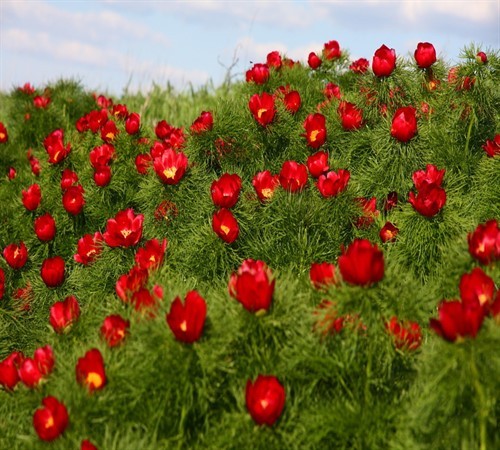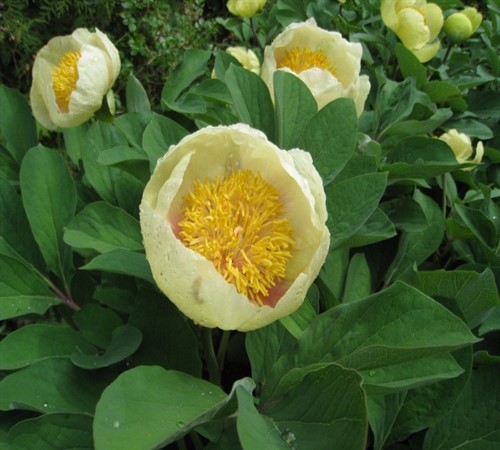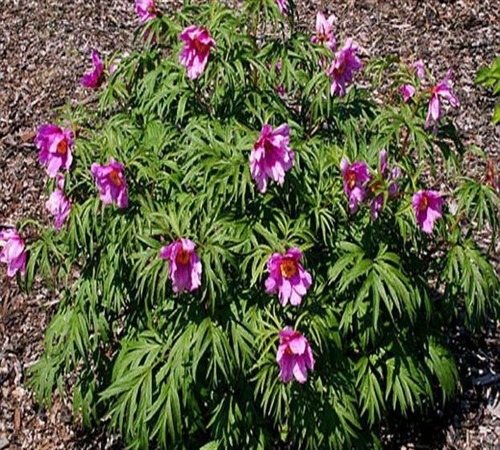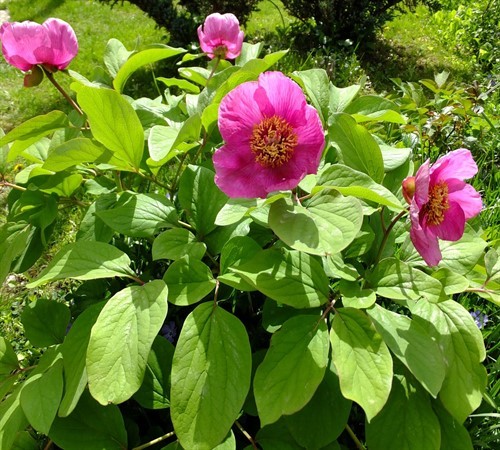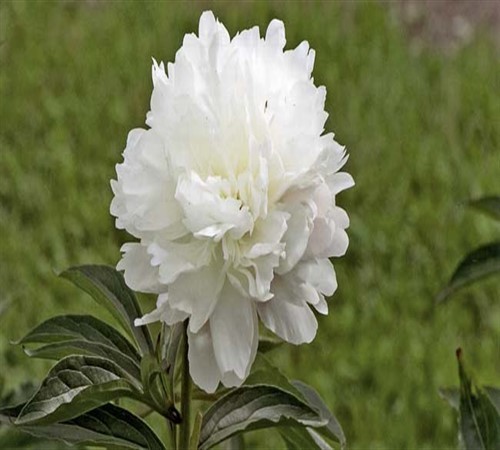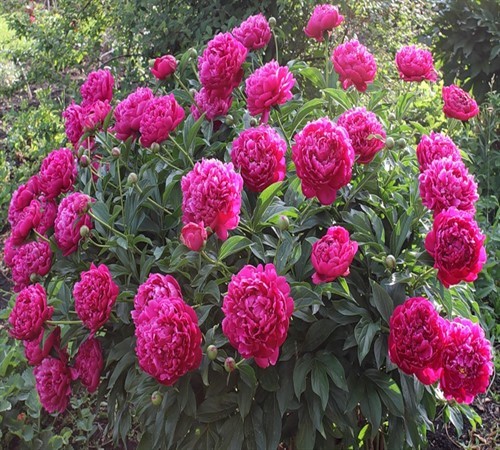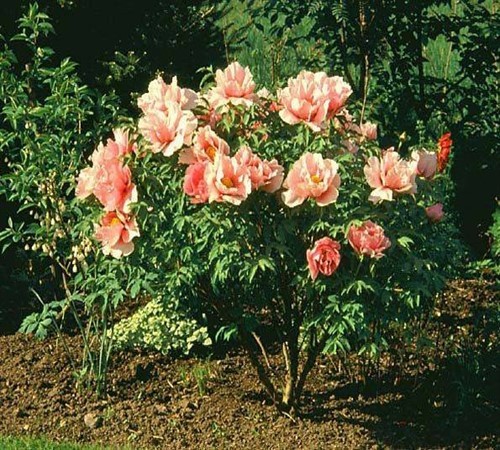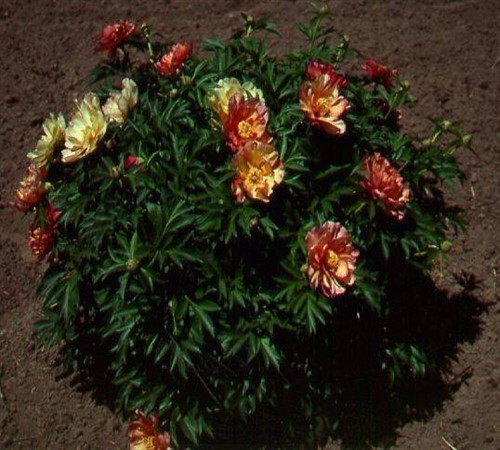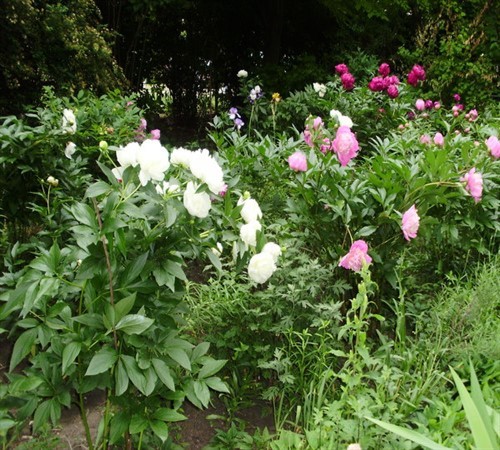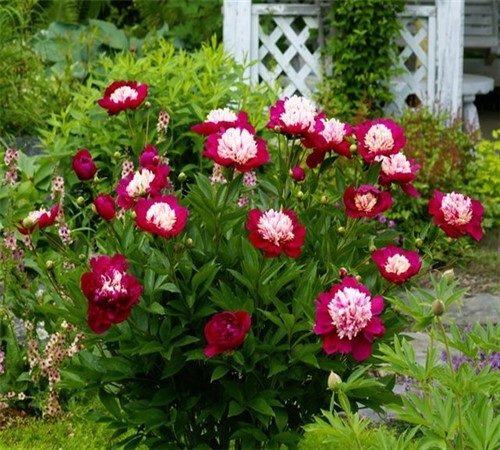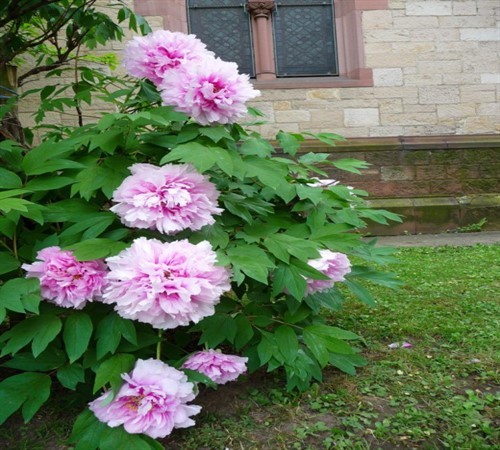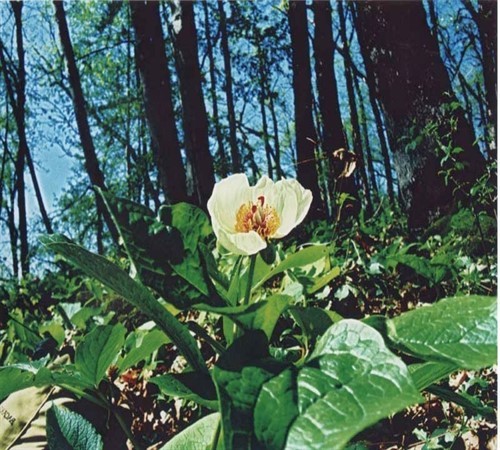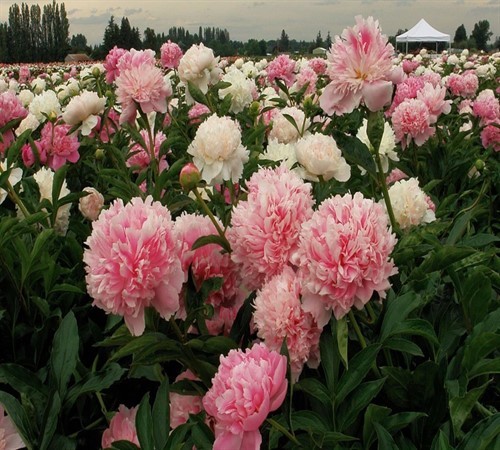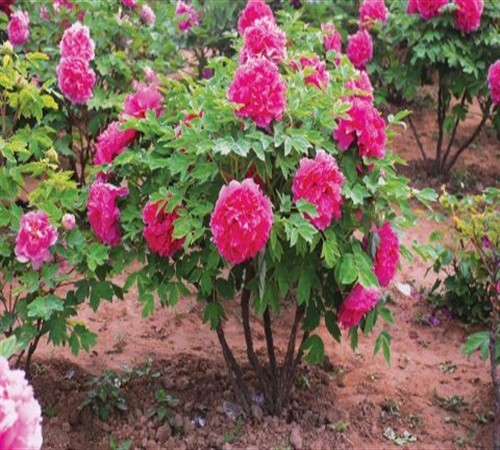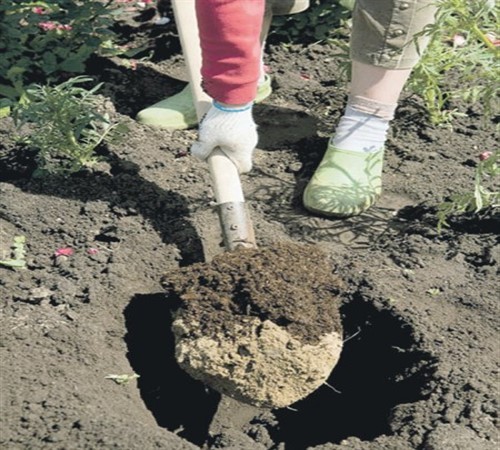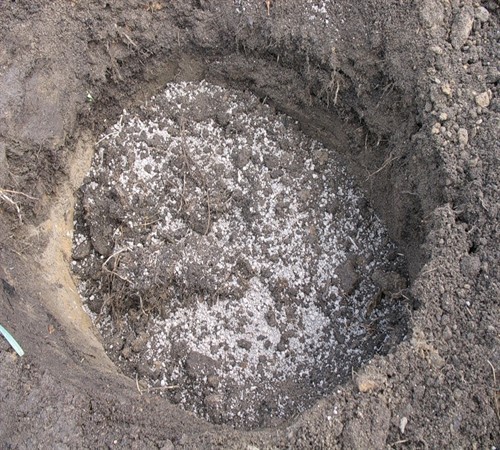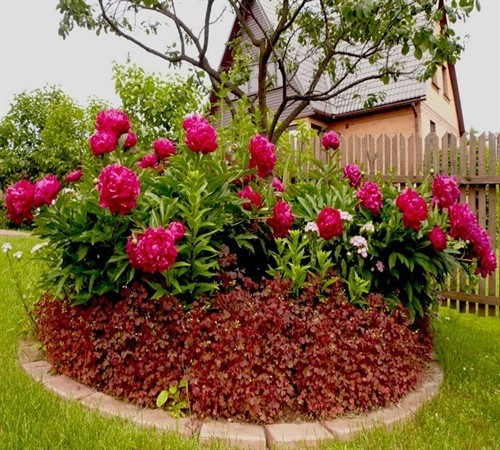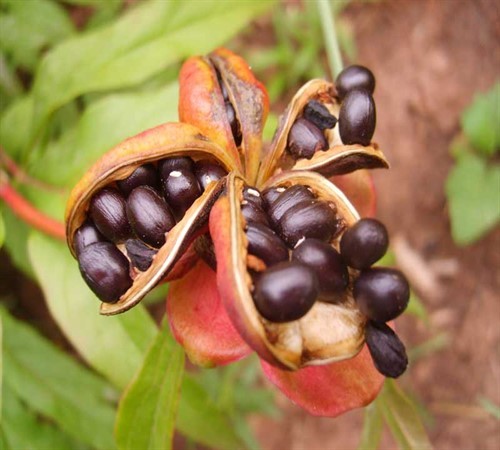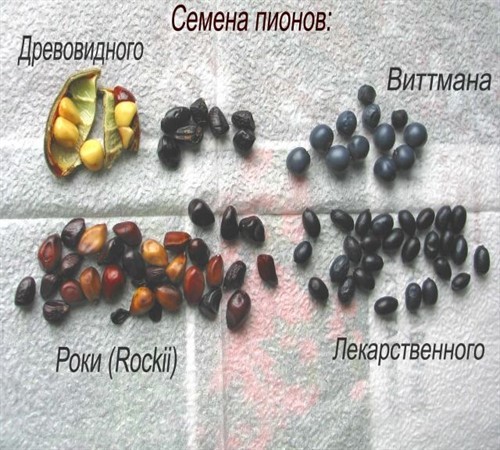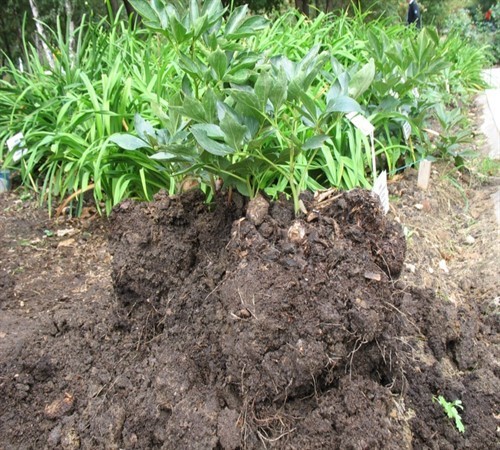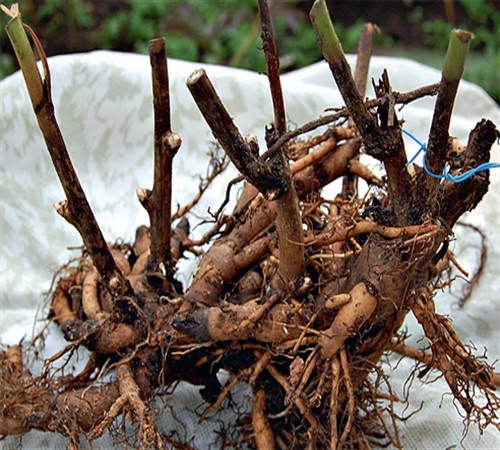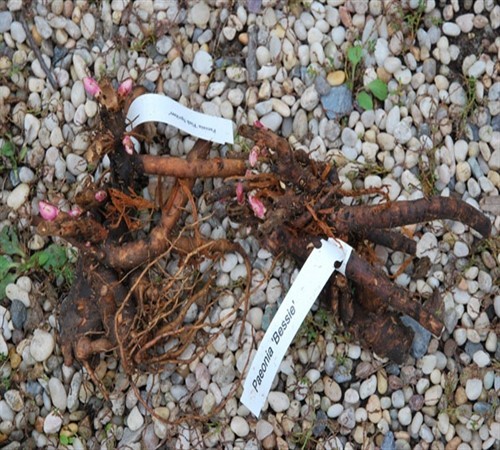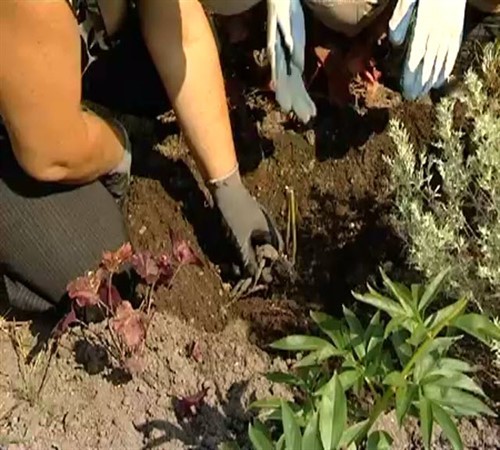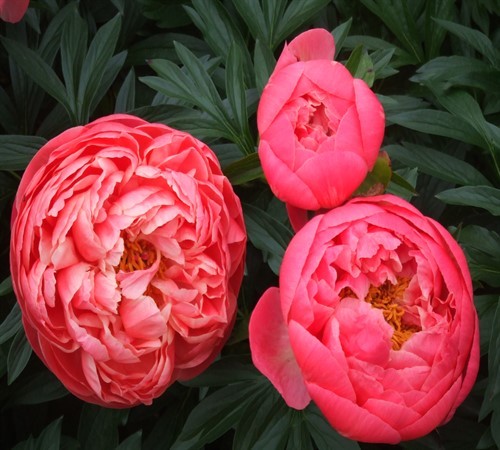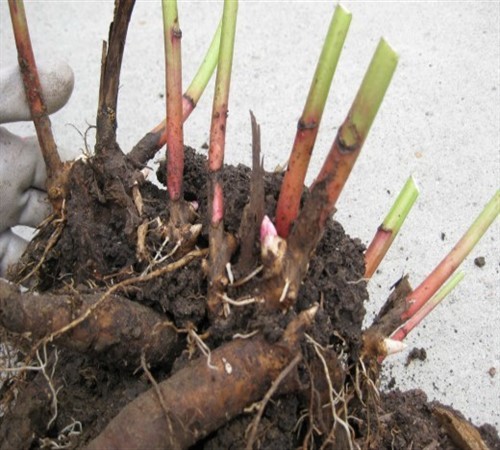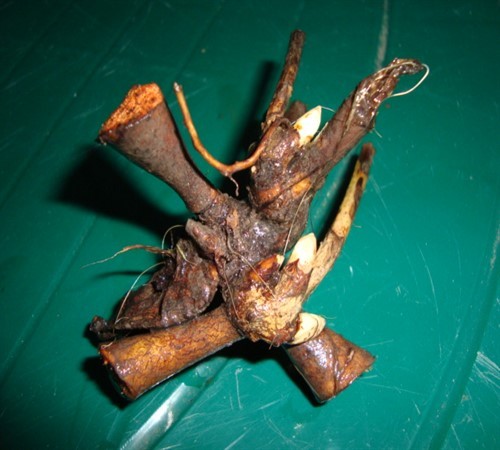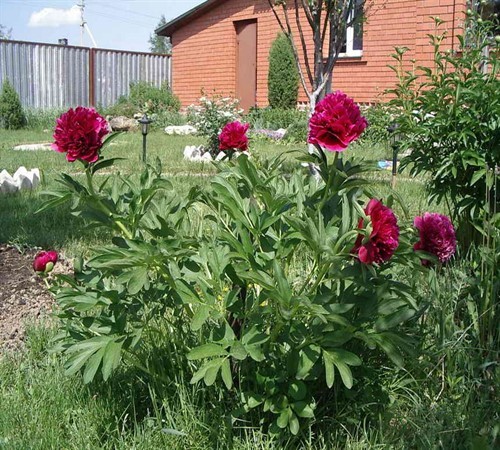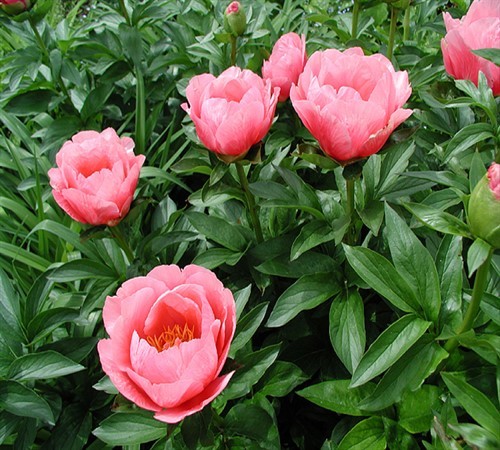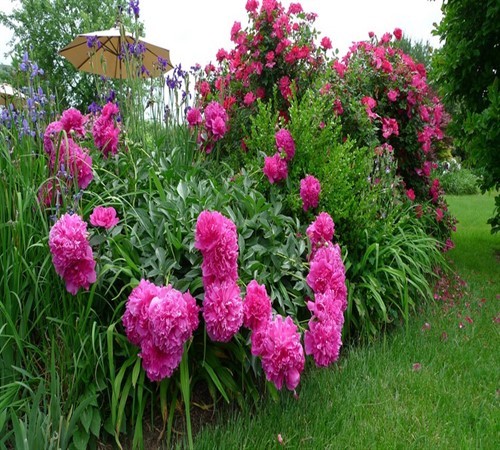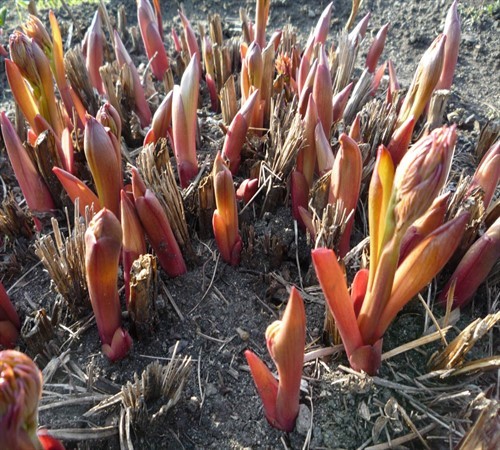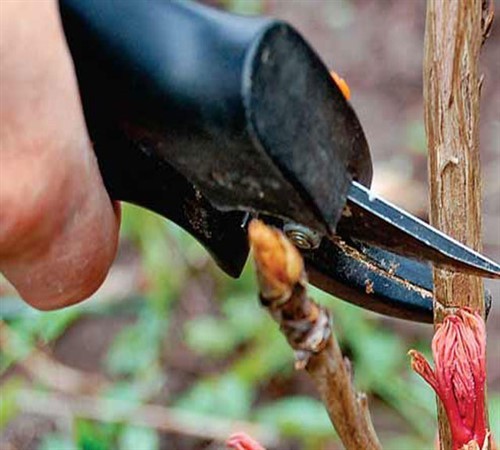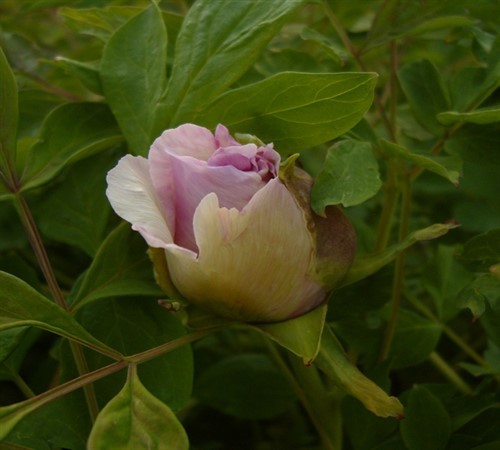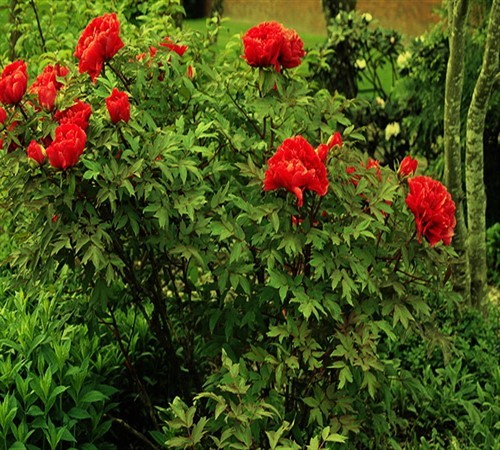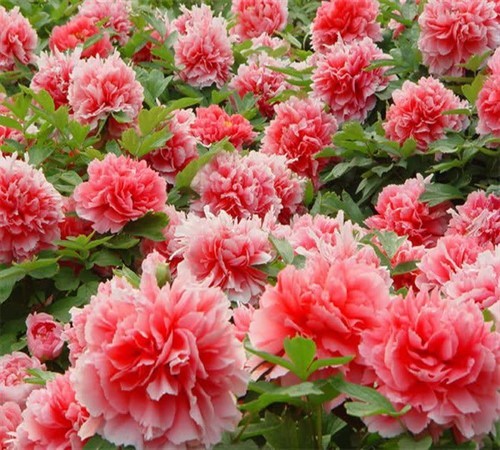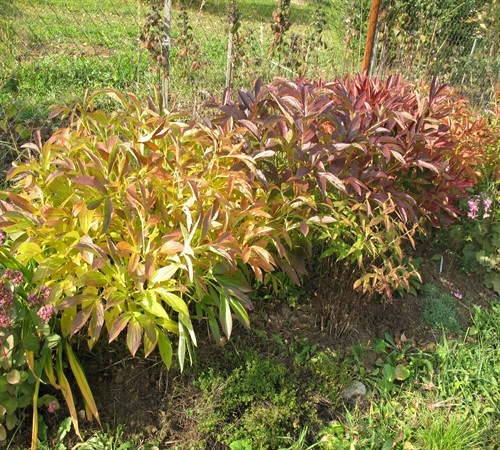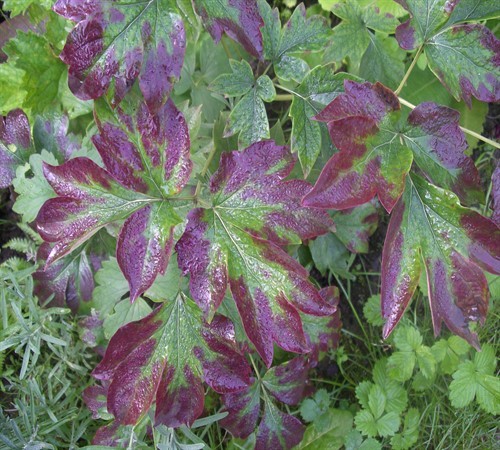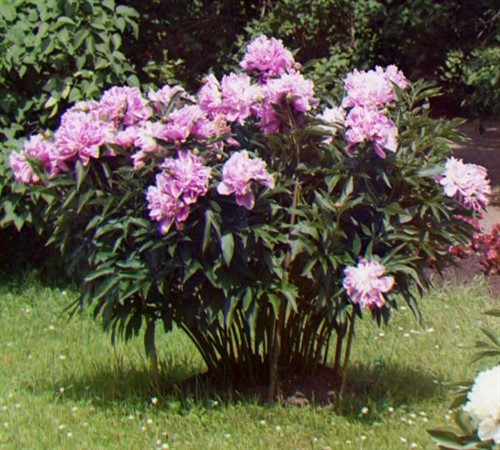
Growing Peonies, Features of Care and Reproduction Plot.
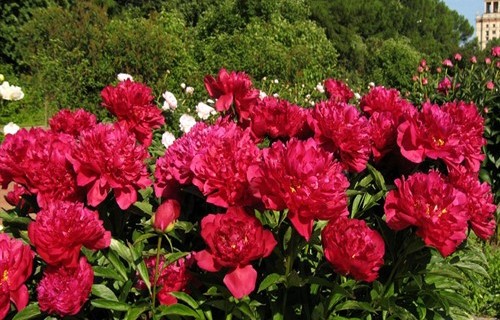
Among the huge variety of colors that adorn the garden, the alley and other different recreation areas, peonies with bulk flowers are immediately distinguished, which are majestically towers over the magnificent leaves of the plant. At the same time, the decorativeness of a variety of peonies largely depends on the species origin of the plant, and the abundance of flowering - from the right choice of the place for the future seedling and compliance with all nuances of planting, reproduction and care. However, before you know how to grow peonies, it is necessary to determine the type of plant.
Content
Selecting planting material
Almost all peonies, with the exception of some varieties imported to us from southern countries, are characterized by excellent resistance and length of growing in one place, but a relatively short flowering period, which is only 2-3 weeks. Extend the pleasure of contemplation of flowering peonies can be selected with varieties with different flowering periods. Therefore, when choosing a particular type of peonies, it is worth considering that the bloom of wild peony varieties begins a month before varieties.
Among wild plants, special attention deserve special attention:
- piona Mlokosovich, Witman, which blooms already in the first days, but require careful care, because they are susceptible to gray rot.
- peony evaded (another name - Maryn root), which will delight with flowers in mid-May. From many other species is distinguished by high frost resistance, decorativeness and resistance to the harmful effects of gray rot;
- a narrow-walled peony blooms in the second decade of May, however, with fading of flowers, the leaves and the loss of all decorative qualities of the plant occurs;
- peony Caucasian, as well as the Crimean begin to bloom at the end of May and attract attention with their carved leaves, retaining decorative qualities from spring to late autumn;
- peony Milk-Flower, having on one stem 3 or more flowers, perfectly opposes the defeat of gray rot and blooms one of the latter in early June.
The variety of varietal peonies, including the greatest variety of varieties, are combined into 3 groups:
1. Herbatous peonies are characterized by a small height of a plant, a component of 50-100 cm, a powerful rhizome, numerous foliage, retaining decorativeness before the onset of frosts, and the most diverse color and structure of flowers represented by simple, terry, semi-friendly, Japanese and anemoid forms. The above-ground part of the peon of grassy in October die, and the rhizome can easily transfers winter frosts. The growing bush occurs within 3-5 years due to annually growing new shoots. Most varieties of grassy plants were obtained as a result of the selection of milky-flower, or a medicinal plant with other intraspecific forms of peonies.
2. The tree peonies are leaf falling shrubs and half-workers reaching in a height of 150 cm. Unlike grassy plants, the peony tree retains the stems with the arrival of winter and discovers only the leaves. At the same time, the increase in the bush in size occurs gradually and the full development of peonies achieve only 7-10 years. Numerous varieties of tree peonies occurred from the Chinese semi-student type peony.
3. ITO-hybrids reach a height of 80-120 cm and combine the characteristics of grassy and tree peonies, being among the average between the two types. In this case, the flower shape and painting are inherited from tree peonies, and the shape and size of the bush - from herbaceous. A distinctive feature of the ITO-hybrids of peony is that at different stages of the blooming of the flower there is a slight change in the shade of its petals. The set of ITO-hybrid varieties is obtained by hybridization of a milky-flower peony with various types of tree shrubs.
The earliest types of varietal peonies begin to bloom from the beginning of June, and the latest varieties are flowing down by the end of July, so combining varieties with a different period of blossom, it is possible to confess 1.5-2 months to admire a variety of plants flowers, although the volumetric bushes of peonies look great not only during Blossoms, but also during periods of calm.
Despite the various species origins and diversity of pion varieties, landing and care for them practically do not differ.
Determination of place of landing
Peonies are rather unpretentious plants, but some moments affecting the durability and abundance of peonies flowering, when choosing a place for the future plant, it is still worth considering.
Place of landing of varietal peonies should:
- well covered, although it is possible to form a small shading in the afternoon from near the plants of shrubs, trees or buildings near the plant;
- it is located at a distance of 1.5-2 m from high trees and buildings, otherwise peonies will suffer from lack of moisture, nutrients, as well as overheating derived from the foundation hot on a hot day.
Wild-growing peonies are less demanding, as they grow in the forests, on the slopes and are more adapted to the natural conditions of the medium, so they feel perfectly well both in the shade and in the sun.
The peonies of any origin are destructively influence near the rooting water, since the roots of the long-growing plant are strongly plunged into the ground, and the constant finding them in wet conditions contributes to the rotation of the root system with the subsequent fibergestion of the plant. In this regard, it is better to choose a place to plant peonies, where the groundwater level is below 1 m.
Thus, to accelerate the growth of the bush and full-fledged flowering, the sun and moderately moisturized loose soil are necessary.
Preparation of soil
For transplantation or landing of peony seedlings, a sublinous alkaline or weakly acidic soil is suitable, an aligned and rich in humus. If you have another type of soil, you need to hold additional activities:
- clay - require 1.5 sand buckets and device of the drainage system, including a layer of gravel or broken bricks with a subsequent sand. The cumulative gravel thickness with sand is 20-25 cm;
- sandy - it is necessary to dilute by humus, clay, compost and turf soil;
- peat - require sand making, along with organic fertilizers and wood ash;
- sour soils are subject to preliminary lime (250-500 g per 1 m²), preferably a year before landing.
For 3-4 weeks before planting seedlings, a pit is digging with a depth of 50-70 cm and filled in equal shares with a mixture of humus, peat, river sand. Over the backfill, it is desirable to add 0.5 liters of ash from birch firewood, a glass of double superphosphate, as well as 1 tbsp. Iron mood. All fertilizers should only take half-pit. The rest of the pit is falling asleep gardening grounds, because planting plants should not touch the fertilizer layer.
Advanced preparation of the pit for planting peonies is necessary for the Earth to settle. The fact is that during the shrinkage, the soil drags the kidney of the plant to a large, which is made, depth, preventing the normal development and growth of peony.
Reproduction of peonies
Increase the number of growing peonies in various ways.
Reproduction of seeds
The fruits of peonies are an intricate long-shaped multistage type. The opening of the leaflet is carried out on the seam located on one side, from the inner side of which large seeds of oval or rounded shape are located. As soon as the seam opens, it is necessary to immediately assemble seeds, and in August to hang them into the ground to a depth of 2-3 cm.
Landing freshly collected, but unbearable peony seeds, contributes to the appearance of shoots already next in spring, while the peony seeds collected 1-2 years ago will delight only in 3-4 years. Flowering of peonies derived from seeds, begins 2-3 years after shoots.
In most cases, wild-growing peonies multiply seeds. Increasing the number of varietal peonies by driving seeds is simply inappropriate, because seedlings retain only a minor share of varietal signs. The varieties of peonies with terry flowers or give a slight amount of seeds, or they are not tied at all. In addition, shoots are only half of the total mass of the sinky seeds, which indicates a high laboriousness, but small productivity. In connection with these circumstances, the largest propagation reaches the method of dividing the bush into several parts.
Reproduction of the division of the bush
The breeding of peonies through the division of the bush is proceeded at the end of August or early September, since by this moment the kidney plants completely voluntary. For crushing, a strongly born bush is chosen, which is at least 5 years. Younger bushes have small rhizomes with tightly located to each other kidney, which greatly makes it difficult to divide the process due to the high probability of damage to the kidneys.
The procedure for performing work comes down to the following:
- choose a suitable bush and cut the stalks at the ground level;
- pipate the bush, retreating 15-20 cm on each side, after which we carefully remove it with the help of forks, trying not to damage the kidneys located on the rhizome. Hold up the bush is also impossible, otherwise part of the roots will turn around;
- clean the rhizome from the ground, we remove the rotten areas and put in the shadow of 5-6 hours so that the root is slightly entered and becomes more plastic;
- we determine the root connection area with the root;
- at the site of the smallest number of kidneys, we score a wooden wedge;
- watching wedge, neatly divide the root into 2 parts, so that the roots do not break away from the rhizomes;
- similarly, we divide each obtained half a few times in half, until 4-5 rhizomes are obtained, each of which has 3-4 kidneys and 2-3 roots;
- volumetric and long decene cut to 15-20 cm at an angle of 45 ° C;
- we lower the obtained parts of the rhizomes into a weak solution of manganese (3 g per 10 liters of water) for 30 minutes, after which we sprinkle with poured charcoal;
- sadim rhizomes in the prepared pits, observing the upper kidney to be not deeper than 5 cm from the soil surface;
- not tamping, fall asleep the earth and water.
With the arrival of frosts, a well with a peony should be closed with a layer of peat about 5-7 cm. The flowering of peonies reproduced with the help of a deteen is observed for 2-3 years, although in some cases it occurs on the next year after landing.
The division of the bush contributes not only to an increase in the number of peonies on the household plot, but also has a positive effect on flowering, since the divided bush is updated. However, it is simply impossible to obtain the planting material in sufficient quantities when dividing the bush is simply resorted to methods of accelerated reproduction of plants by means of renewal kidneys.
Reproduction of kidneys
The reproduction of peonies by dividing the bush is often accompanied by the production of additional planting material. For this:
- at the time of dividing the bush, we cut a small piece of rhizomes having 2-3 renewal kidney, the size of which reached 1-1.5 cm;
- disinfect every piece in a weak solution of manganesev, and the location of the cut is sprinkled with charcoal;
- landing pieces of rhizomes with kidneys at a distance of 10-15 cm from each other into the greenhouse or a rampant board, drowning into the soil consisting of humus, sand and earth, 2-4 cm;
- abundantly moisturize;
- for the winter period, seedlings are covered with a layer of straw about 20 cm or dry foliage.
In the spring, and better the next fall, planted seedlings at a permanent place.
Get a renewal kidney can be without digging a bush:
- gently remove the upper layer of the Earth so that part of the kidney root is visible;
- sut the required piece;
- the cut on the rhizome is treated with a solution of manganese and sprinkle with charcoal;
- i fall asleep a bush of the earth.
Cut all the kidneys from the rhizoma can not, otherwise the plant will die.
Despite the simplicity of the method, it is possible to quickly get the planting material not only by the renewal kidney, but also with cuttings.
Reproduction of cuttings
The billet of shoots is carried out in the morning, or in cloudy weather 2-3 weeks before the upcoming flowering. For landing, the cuttings are longer than 6-8 cm long, obtained from the central part of the stem.
The process of reproduction with stalk cuttings is as follows:
- cut the stem selected for the reproduction of peonies so that the lower slice is under the first sheet, and the upper one is over the second;
- similarly, we produce the division of the entire stem to separate shoots;
- large leaves on the received shoots are immediately cut to prevent abundant evaporation, and minor - leave in its original form;
- i am lowering for 10-15 minutes to the dilution with water a solution of manganese;
- rooting the cuttings in the greenhouse so that the sinus of the lower sheet be covered with sand 1-2 cm by choosing a mixture of vermiculite and sand as a substrate, whose layer is 6-7 cm;
- soots sit down in 8-10 cm, withstanding the distance between rows of 15-20 cm so that the leaves of neighboring shoots did not touch;
- the greenhouse is closed with glasses that are pre-painted with chalk;
- 3-4 times a day of shoots spray with water, observing the temperature regime at 21-25 ° C;
- a month later, we begin to gradually raise the frame and reduce the number of day irrigation to 1-2 times.
Under all the conditions of landing, the slice of escape is delayed after 30 days, the roots appear on the 50 day, and the renewal kidneys are formed only 2.5-3 months after landing in the greenhouse.
By the beginning of September, the roots of the shoots grow up to 15-20 cm, the kidney of the future plants begged and begin to develop. From this point on, the frame is cleaned at all, although with the onset of winter, the greenhouse is again closed with frames, and the kidney appears are sprinkled with a compost or land. In addition, the greenhouse also needs to fall asleep to the leaves until spring.
In the fall of the next year, rooted shoots are transplanted to a permanent place. The flowering of landfits occurs for 2-3 years.
The rooting of the cuttings is performed quite slowly and is not always successful, although it allows you to increase the number of peonies without prejudice to the growing bush.
Thus, the peonies growing on the section can be properly in a variety of ways, but without proper care, the most unpretentious flowers, peonies are no exception, they will simply die.
Pion care
The whole process of growing peonies and care for them can be divided into 3 stages.
Spring care
With the arrival of spring, as soon as snow comes down, and the sun warms the top layer of the soil, the red-made shoots of herbaceous peonies begin to cry through the layer of mulch. For normal development and growth of young shoots, the first, nitrate-potassium, feeding is made. Accelerating the growth of the kidneys, roots, as well as the protection of peonies from damage to the gray rot, contributes to the processing of shoots with a solution of manganese (by 10 liters of water about 3 g of manganese). Since the stalking part of herbaceous shoots increases up, then as they are rapidly being added to the bush of humus ground.
In early April, the trimming of dried and broken branches of tree peonies is required. The frozen tops of branches or shoots are cut later when all the kidneys are completely dissolved. However, it should be borne in mind that the freshest kidneys are dissolved a little later than full. Along with herbal, tree peonies also need disinfection and feeding.
If the peonies planted in the fall bloom in the first year, the flowers will need to be removed so that they do not pull the nutrients, and they gave the root system to develop normally.
Careful care contributes to the growth and abundant flowering of herbaceous and tree peonies.
Care in the summer
Most varieties of various types of peonies bloom at the end of spring or early summer. To improve and the abundance of flowering, plants require feeding nitrogen, potassium and phosphorus.
The oversupply of nitrogen is accompanied by lush foliage, but rather poor blossoms.
Once a week is required to pour about 2 buckets of water under the bush, and in the arid summer 2-3 times a week.
After 2-3 summer blossoms from the plant, it is necessary to remove the loops of buds, leaving only 3-4 central buds, then the flowers will be larger and luxurious.
When cutting the stems of peonies to form a bouquet, it is necessary to leave 2-3 sheets on the cutting breakdown, so as not to break the flowering of the bush in subsequent years.
Faded flowers are removed from the plants immediately, if there is no need to receive seeds, otherwise the plant will be depleted.
After the end of flowering, the third feeding of peonies is performed by superphosphate or potassium sulfate, which stimulates the development of renewal kidney, ensuring growth and flowering next year.
In rainy weather, peonies are processed by drugs containing copper, in order to avoid damage to flowers and boutons with gray rot.
Care in autumn
The above-ground part of the stems in grass-type peonies with the onset of autumn frosts die, so it must be trimmed, and the remains sticking out of the soil stems to mulk peat.
Bushes of tree peonies, especially during the first 3 years after disembarking in the ground, should also be covered with wood chips or fallen foliage. At the same time, the branches of the bush are preliminarily associated with a twine, preventing the rustling of them under the weight of snow, as the wood in peonies is quite fragile.
Regardless of the season, the soil near the peon bushes, especially after the rains, it is necessary to loosen at a depth of 8-15 cm, retreating from the bush 15-20 cm. Ruffer contributes to the preservation of moisture, the fight against weeds and prevents the formation of the crust.
Inalienable work when leaving for plants is periodic canopy, since weeds absorb water, create neglence, suck nutrients, worsen aeration and contribute to the spread of various diseases. After each weeding, the soil is mulched.
Thus, the whole care for peonies is reduced to a timely tie, feeding with mineral and organic fertilizers, as well as timely watering in the summer and autumn, when the kidney lays occurs.
Compliance with all nuances of planting, breeding and care of peonies contributes to abundant flowering, accelerated growth and full-fledged plant development.




